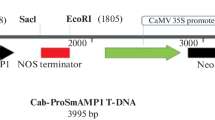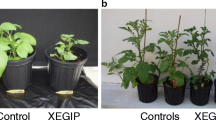Abstract
Cecropin B is a peptide of approximately 4 kDA which shows antimicrobial activityin vitro against Gram positive and Gram negative bacteria. Potato cvs Agria, Bintje, Karnico, Kondor and Producent were transformed with a gene construct encoding a cecropin B precursor polypeptide. In total, 49 independent transgenic potato clones were obtained. Northern blot analysis of these plants revealed that the introduced gene was transcribed to detectable levels in almost all plants, the highest transcription level being approximately 0.6% of total mRNA. No cecropin B peptide could be detected in transgenic plants, probably as a result of rapid proteolytic degradation of newly synthesized cecropin B by potato endogenous proteases. Neither small tubers of a group of 11 clones with moderate to high transcription levels nor slices from field grown tubers of any of the transgenic clones obtained, showed significantly (P<0.01) less rot after inoculation withErwinia carotovora subspatroseptica orE. chrysanthemi, the plant pathogenic bacteria that cause potato soft rot.
Compendio
Cecropin B es un peptido de aproximadamente 4 kDA que muestra actividad antimicrobianain vitro contra las bacterias Gram positivas y Gram negativas. Los cultivares de papa Agria, Bintje, Karnico, Kondor y Producent fueron transformados con un prototipo de gene que codifica un polipeptido precursor de cecropin B. En total, se obtuvieron 49 clones independientes de papa transgénica. El análisis de estas plantas, mediante la transferencia del RNA a placas de nitrocelulosa (Northern Blot Analysis), reveló que el gene introducido fue transcrito a niveles detectables en casi todas las plantas, siendo el nivel más alto de transcription de aproximadamente 0.6% del mRNA total. No se pudo detectar al peptido de cecropin B en las plantas transgénicas, probablemente debido a una degradación proteolítica rápida del cecropin B nuevamente sintetizado, por las proteasas endogenas de la papa. Ni los pequenos tubérculos de un grupo de 11 clones con niveles de transcriptión moderados a altos ni las rebanadas de tubérculos obtenidos del campo, de cualesquiera de los clones transgénicos obtenidos, mostraron una pudrición significativamente menor (P<0.01 ) después de la inoculation conErwinia carotovora subsp.atroseptica oE. chrysanthemi, las bacterias patógenas causantes de la pudrición blanda de la papa.
Similar content being viewed by others
Literature Cited
Boman, H.G. and D. Hultmark. 1987. Cell-free immunity in insects. Ann Rev Microbiol 41:103–126.
Destéfano-Beltrán L., P.G. Nagpala, M.S. Cetiner, J.H. Dodds and J.M. Jaynes. 1990. Enhancing bacterial and fungal disease resistance in plants: Application to potato.In: Vayda, M.E. and W.D. Park (Eds.), The molecular and cellular biology of the potato, C.A.B. International Publishers, Oxon, UK. pp 205–221.
De Wit, P.J.G.M. and G. Spikman. 1982. Evidence for the occurrence of race and cultivar-specific elicitors of necrosis in intercellular fluids of compatible interactions ofCladosporium fulvum and tomato. Physiol Plant Path 2:1–11.
Florack, D., S. Allefs, R. Bollen, D. Bosch, B. Visser and W. Stiekema. 1995. Expression of giant silkmoth cecropin B encoding genes in transgenic tobacco. Transgenic Research 4:132–141.
Florack, D.E.A., W.G. Dirkse, B. Visser, F. Heidekamp and W.J. Stiekema. 1994b. Expression of biologically active hordothionins in tobacco. Effects of pre-and pro-sequences at the amino and carboxyl termini of the hordothionin precursor on mature protein expression and sorting. Plant Mol Biol 24:83–96.
Hightower, R., C. Baden, E. Penzes and P. Dunsmuir. 1994. The expression of cecropin peptide in transgenic tobacco does not confer resistance toPseudovwnas syringae pvtabaci. Plant Cell Rep 13:295–299.
Hoekema, A., MJ. Huisman, L. Molendijk, P.J.M. van den Elzen and B.J.C. Cornelissen. 1989. The genetic engineering of two commercial potato cultivars for resistance to potato virus X. Bio/Technology 7:273–278.
Jarret, R.L., P.M. Hasegawa and H.T. Erickson. 1980. Factors affecting shoot initiation from tuber discs of potato (Solanum tuberosum). Physiol Plant 49:177–184.
Jaynes, J.M., P. Nagpala, L. Destéfano-Beltrán, J.H. Huang, J. Kim, T. Denny and S. Cetiner. 1993. Expression of a Cecropin B lytic peptide analog in transgenic tobacco confers enhanced resistance to bacterial wilt caused byPseudomonas solanacearum. Plant Sci 89:43–53.
Jia, S-R., Y. Xie, T. Tang, L-X. Feng, D-S. Cao, Y-L. Zhao, J. Yuan, Y-Y. Bai, C-X. Jiang, J.M. Jaynes and J.D. Dodds. 1993.In: You, C., Z. Chen and Y Ding (Eds.), Genetic engineering of Chinese potato cultivars by introducing antibacterial polypeptide gene. Biotechnology in agriculture, Kluwer Academic Publishers, The Netherlands. pp 208–212.
Lapwood, D.H. and P.J. Read. 1985. A simplified slice method for assessing tuber susceptibility of potato cultivars toErwinia carotovora subsp.atroseptica. Plant Pathol 34:284–286.
Lee, J-Y., A. Boman, S. Chuanxin, M. Andersson, H. Jörnvall, V. Mutt and H.G. Boman. 1989. Antibacterial peptides from pig intestine: Isolation of a mammalian cecropin. Proc Natl Acad Sci USA 86:9159–9162.
Nordeen, R.O., S.L. Sinden, J.M. Jaynes and L.D. Owens. 1992. Activity of cecropin SB37 against protoplasts from several plant species and their bacterial pathogens. Plant Sci 82:101–107.
Mills, D. and F.A. Hammerschlag. 1993. Effect of cecropin B on pathogens, protoplasts, and cells. Plant Sci 93:143–150.
Stiekema, W.J., F. Heidekamp, D. Louwerse, H.A. Verhoeven and P. Dijkhuis. 1988. Introduction of foreign genes into potato cultivars Bintje and Désirée using anAgrobacterium tumefaciens binary vector. Plant Cell Rep 7:47–50.
Author information
Authors and Affiliations
Rights and permissions
About this article
Cite this article
Allefs, S.J.H.M., Florack, D.E.A., Hoogendoorn, C. et al. Erwinia soft rot resistance of potato cultivars transformed with a gene construct coding for antimicrobial peptide cecropin B is not altered. American Potato Journal 72, 437–445 (1995). https://doi.org/10.1007/BF02851677
Accepted:
Issue Date:
DOI: https://doi.org/10.1007/BF02851677




